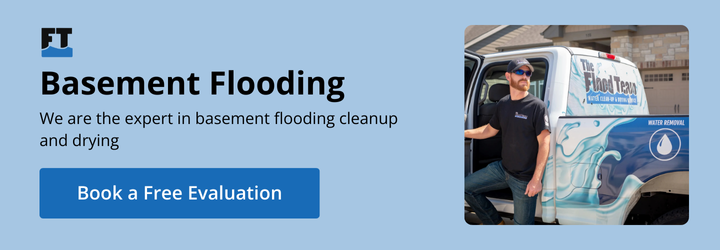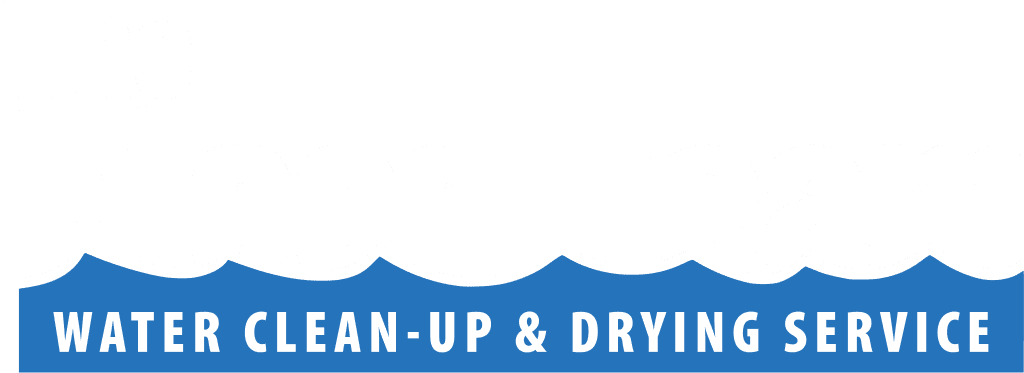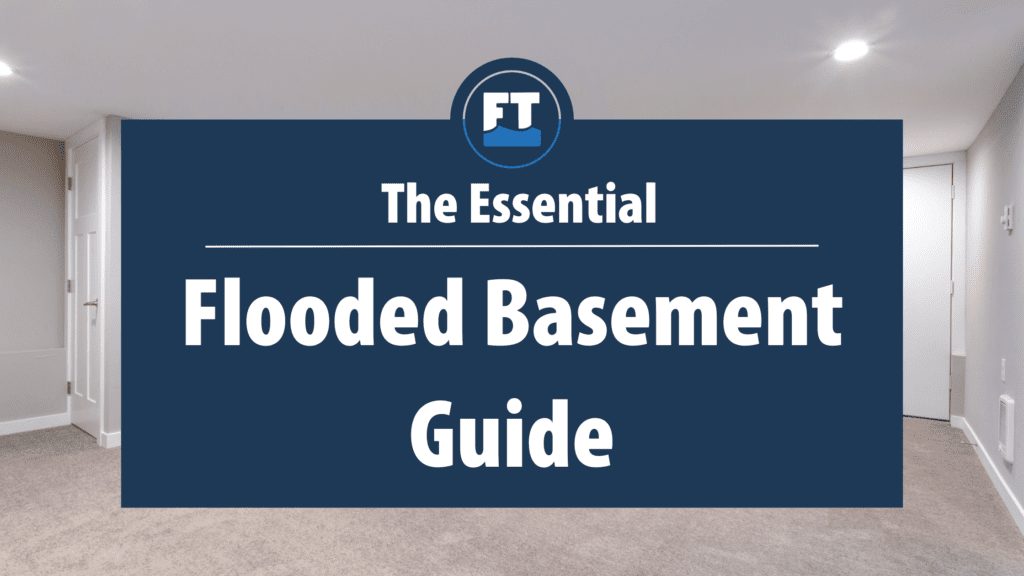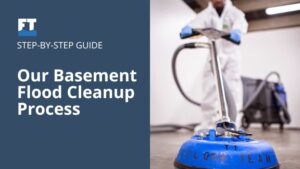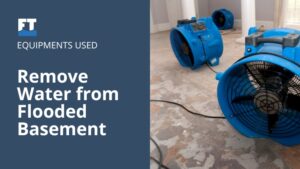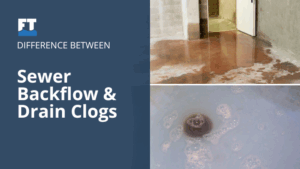Basement Wet? No Sweat!
You’ve purchased your home sweet home with a bonus basement. It’s where you plan to lounge as a family, furnish a guest room or in-law suite, or simply have extra space to work or retreat. But one day, a climb down basement steps leads to a humid surprise and a sight for sore eyes—a soggy basement mess!
You didn’t prepare for the unforeseeable basement future that involves a flood, something too many homeowners have endured.
The flood may be due to heavy rainfall seeping through your basement walls or foundation. This is often because of inadequate drainage surrounding basement walls. Other common causes include sump pump failure, leaks, and plumbing dilemmas. No matter the reason, water draining into your basement can potentially cause significant damage to your health, home’s foundation, and belongings, so acting fast after the initial shock subsides is a must.
You’ve experienced the shock.
You’ve endured the stress.
Now it’s time to learn how to address a flooded basement mess.
The good news? You’ve come to the right place! Here you’ll find 10 clean-up pointers from a water remediation pro. Be assured that basement flood damage doesn’t have to end your basement’s story. You can still plan for an enjoyable and dry basement future. There are things you can do to restore your basement, peace of mind, and the comfort of your home sweet home.
How to Clean a Flooded Basement in 10 Steps
Step 1: Determine the source of basement water intrusion.
Water intrusion happens when water enters an unintended space. There are several sources of water intrusion where a basement flood is concerned, which will help to determine your home’s clean-up process. The cause of the basement flood will also determine whether an insurance company will cover the cost of damages and repair.
For instance, many insurance policies don’t cover basement floods due to ground seepage. Ground seepage happens when a lot of water accumulates in the ground near a basement wall. The pressure from this excess water causes water to “seep” into small holes and cracks in the walls or foundation. So, it’s imperative to identify the source or call a trained professional like The Flood Team to diagnose the cause if all else fails.
Step 2: Become Familiar With Common Causes Of Basement Floods
If you decide to diagnose the problem, becoming familiar with the common causes of basement floods is key. Where a basement is concerned, not to overuse a common saying: “Knowing IS half the battle.”
The most common causes of basement floods include:
Sewer Backup
Overflow from sewer blockage is where sewage or wastewater overflows from a drain, toilet, or sink due to blocks in the sewer pipe on your property. The blockage prevents waste or wastewater from moving freely.
Main city sewer backups happen when the sewer line in the surrounding area is clogged or blocked. This often occurs when a city’s sewage system is overloaded, resulting in sewage flowing backward into homes. These are commonly found in toilets, bathtubs, and basement drains.
Seepage
As mentioned, seepage is when excess water accumulates in the ground near a basement wall. This creates hydrostatic pressure, where gravity pushes the liquid into small holes and cracks into the walls or floor of a basement. Seepage also occurs when water pools at windows or window wells, draining into the basement.
Sump Pump Failure
A sump pump is a device placed within a pit carved below the main surface of your basement floor. Its purpose is to move water from within your basement to outside your home. When the sump pump fails, excess water can pool in your basement, creating a flood.
Grinder Pump Failure
A grinder pump is used with homes lower than the sewer main. It forces water waste up to the main sewer pipes, working like a garbage disposal, grinding wastewater away from home and pumping it into the city’s sewer system. A siren usually indicates that the grinder pump has failed or stopped working, resulting in an overflow or backup.
Plumbing Failure
Water heater leaks
Toilet water or wastewater overflow
Appliance malfunction
Still don’t know the source? Then a plumber, drain inspector, or waterproofing professional may help you identify the root cause. When addressing the water damage, a reputable water restoration company like The Flood Team can not only diagnose the issue but also help dry, clean, and restore your basement and peace of mind.
Step 3: Determine The Water Category
Upon identifying the source, it is imperative to consider the water category. This is based on the amount of contamination in the water. While all water contains some bacteria, depending on the source and how long it has been standing, some water can pack a more potent pathogenic punch and have serious adverse health effects. Determining the water category will also help you decide which of your wet belongings is salvageable. While some building materials can be dried and saved depending on the water category associated, other materials are recommended for disposal because they have absorbed contaminated water that cannot be cleaned and sanitized.
The following is a simple guide to help you determine the water category:
Category 1 – Water from a Fresh Source
- Pipe break
- Water heater
- Sink overflow
- Water line
Category 2 – Semi-Contaminated Water
- Groundwater
- Seepage
- Sump pump failure
- Broken aquarium
Category 3 – Highly-Contaminated Water
- Sewer Backup
- Drain Overflow
- Rainwater Flooding (Water that comes in from the street level)
Step 4: Determine the Scope of Work
To plan for success in addressing a flooded basement, you’ll first need to know what a successful clean-up job will entail–from necessary safety precautions and the extensiveness of work. Here are some of the critical things to consider before attempting a basement flood clean-up on your own:
Consider necessary safety precautions involving standing water in a basement.
- Turn off electricity if water is above outlets or “live” electrical devices are in the standing water. This may be difficult because many electric boxes can be found in basements.
- In cases where turning off electricity is difficult, you may need to attempt to get the water down before entering.
- Another option is to contact a professional water restoration company like The Flood Team, who knows how to enter flooded basement spaces safely so you won’t have to.
- Do not enter without PPE. Personal protective equipment (PPE) is worn to reduce exposure to hazards that can cause serious illness or injuries. It may include electrically insulated, watertight boots. Tennis shoes or sneakers should not be worn because they will transfer contamination and will not prevent electrical shock. Hip waders may also help avoid contact with flood waters, depending on how high the flood water is in the basement.
Consider the size of the flood or water loss.
- Is the entire basement flooded and is there standing water?
- Are there just a few rooms or areas affected by the flood?
Consider how you will find ALL water!
Finding all water, especially in unseen spaces, can be challenging. It is essential to the integrity and safety of your home to find and dry all water. Certified water remediation professionals will bring out moisture meters that can detect water and high moisture content levels. What is seen and felt as dry to the naked eye and touch can actually be hiding water. Without moisture meters, much guesswork is involved which can prove problematic in the long run. Because there is a good chance water can be left unnoticed without a professional’s water-detection, secondary damage, like mold, can create additional problems. To ensure water is not left behind and the humidity level returns to normal in your basement, contacting trained professionals like The Flood Team is highly advised.
Special note: Water is sneaky! Water does a great job seeping under walls into rooms or areas you may have overlooked, such as closets, under cabinets, stair cavities, and other hidden spaces.
Also, water easily and quickly absorbs up walls and other materials in a capillary action. Water is sticky, preferring to stay together (cohesion) and adhere to surrounding materials (adhesion). In a capillary action, water sticks to walls, causing it to absorb upward.
Determine the salvageability of building materials and belongings.
Again, to determine the salvageability of building material, you must consider the water category. If category 2 or 3 water absorbs into walls and flooring, building materials may be unsalvageable because the area may be inaccessible for sanitization.
Common Basement Building Material:
- Walls
- Drywall
- Paneling
- Flooring
Step 5: Determine whether to make a claim or self-pay.
Depending on how your basement is flooded, you may or may not have coverage. Refer to The Flood Team Coverage Determination Guide below.
It is recommended that a professional help determine the actual cause of water loss. A misdiagnosis can lead to coverage denial and cost you more in the long run. The Flood Team will not only diagnose your water loss issue, but if a claim is required, our trained insurance specialist will contact the insurance company on your behalf. We provide all necessary documentation and receive direct payment from insurance, so you pay nothing out of pocket. Should you incur out-of-pocket costs because insurance does not cover damage, we will match estimates from any reputable water remediation company in your area.
Step 6: Remove water/ basement contents.
Now that you or a certified professional has identified the source of water intrusion, the water category, the scope of work, and whether an insurance claim is necessary, the next step would be to begin removing water and remove or move basement contents.
While moving basement contents may appear simple, sometimes this can be the BIGGEST problem in a flooded basement. You’ll need a gameplan.
Most basements contain furniture and often serve as a home’s extra storage space, so unless standing water needs to be pumped out, the first step before extracting water is to organize and handle the wet contents of the environment.
Extra Storage: Is there a dry location to store basement contents? If the water is contaminated, you will want to create an area where you can set aside wet things without cross-contaminating your clean space and belongings. You can do this by placing plastic where you set contaminated items. Also, place plastic along the floor trafficked going back and forth from that contaminated location. If you do not have additional space, this is where mobile storage units come in handy. You can use portable storage to have a temporary place to store these items.
Order A Dumpster: A dumpster may be required depending on the salvageability of the material and how much damaged content you have. In many flooded basement scenarios, a dumpster is a necessity. It is essential to set aside important items before disposing of them, documenting them by taking a picture and keeping a log of how much these items cost you, perhaps including the purchase date. This will help with getting reimbursed by the insurance company.
Manipulate Content and Block Furniture: The first thing you want to do depends on the salvageability of the flooded basement material. Say the flood involves a clean or semi-clean water source. You want to salvage the walls and flooring, assuming they can be dried. You will first want to move all contents to the room’s exterior and extract water from the center. Then you will want to move all the contents to the center and “block” the legs with foam blocks so that all furniture is no longer touching the ground and can have airflow underneath. Following this step, you can begin to extract the exterior parts of the room. This also helps because now all the walls in the room are exposed. You should be able to walk around the room and easily see all exterior walls. This is important because you will need this space to install fans to restore walls.
Extracting Water: Extraction is a vital part of the process. Extraction is 1,200 times faster than the process of evaporation, so the more water you remove, the quicker the flooded basement dries.
Carpet and Pad – This may be the most challenging material to remove water. It is only recommended to try and save the carpet pad depending on the water’s contamination level. You may need to remove the pad and sometimes the carpet as well. There are cases where the water contamination is low enough, and you would like to salvage the carpet and pad. In this instance, the first thing to do is check for the type of padding under the carpet. Suppose the pad has a plastic barrier on top, usually called a vapor barrier. In that case, the pad will need to be replaced because you will not be able to remove all the water from the pad in a reasonable time before mold has the potential to thrive.
Also, there are only certain extraction tools that can successfully pull water out of padding through the carpet without having to pull back all of the carpet, in which case the carpet loses 80% of its strength. You can easily damage the carpet by trying to maneuver it when wet. Some professional companies have special weighted extraction tools. If you do not have these tools, your only alternative would be to either pull back the carpet and extract the pad or remove the pad and lay the carpet back down. Then you can always have a carpet installer install new padding later.
Glued-Down Carpet – Glued-down carpet is usually one of the easier surfaces to extract and will not only remove water fairly easily but also dry quickly.
Carpet Tiles – This can be tricky. Some of these tiles have a heavy vapor barrier at the bottom, so they can leave moisture between the carpet and the concrete, creating bacteria in the carpet to eventually warp or appear uneven. If it is a small area, you can usually pull a few up and let them dry out by getting airflow on them and laying them back in place. You may also have some spare replacement tiles. When a larger area is affected, this can pose a bigger challenge. A lot of times, you may find it is best to replace them even after trying to salvage all of them.
Hard Surfaces – Hard surfaces are another area where removing water with the proper extraction tool is pretty easy. Unfortunately, most homes are only equipped with a shop vac, which is great, but when a large area is wet, it can be very time-consuming and physically exhausting. Some water restoration specialists like The Flood Team have specialized power extraction machines designed to continually extract and pump out the water.
Step 7: Cleaning
Hard Surface Cleaning – Depending on the degree of contamination, it may be necessary to pressure wash the floors after removing the flooring to clean any contaminated debris.
Spraying Antimicrobials – It is essential to safely spray an antimicrobial solution on the floor after pressure washing. Please note that all antimicrobials are inactivated by organic matter, meaning the surface you spray must be as clean as possible (free of debris) for an antimicrobial to effectively kill the bacteria on the surface. Many professional antimicrobials are safe to spray on all surfaces like carpet and pad. These antimicrobial agents are perfect for water losses involving semi-contaminated water. This will help slow the growth of bacteria (and mold under the right conditions). This is also perfect for wiping down and disinfecting all contaminated contents.
Step 8: Drying
The next important step in the restoration process is drying. This involves creating and controlling a property’s indoor environmental conditions. There are 3 ways we can control indoor conditions: We call this HAT, which stands for Humidity, Airflow, and Temperature. HAT is essential for creating a drying environment that speeds up evaporation. HAT follows a drying science called psychrometry, which involves the mixture between air and water vapor. The following are some of the main components associated with psychometry drying science.
Air Movers – In psychometry, air movers aim to push away moist or humid air surrounding wet basement contents such as carpet, walls, and furniture. This permits less humid or drier air to surround the wet object so evaporation can continue. Reducing the relative humidity near a wet area through air movers helps speed up evaporation.
Dehumidifiers – Humility levels of 30-50% within homes are normal. However, humidity levels will likely rise to 60% in a flooded basement. When this occurs, the environment becomes unhealthy. Surrounding contents may also begin to absorb the moisture and potentially swell, experiencing secondary water damage. A humidifier will help reduce the air’s relative humidity and aid in drying and evaporation. Additionally, a high-humidity environment is a breeding ground for mold, so addressing humidity issues during the drying process is beneficial for drying and mold growth prevention.
Temperature – Believe it or not, temperature is important in a flooded basement’s drying process. A key part of psychometry is measuring the relative humidity and temperature of the basement air. This helps a water restoration specialist determine how to set up an adequate drying system where the air is the driest and has the greatest capacity to hold moisture. In short, adequate temperature helps to speed evaporation, which mitigates additional water damage to property. The technician will need to create an environment utilizing the hottest air available, whether outside air, known as an open drying system or a closed drying system (if the air outside is too cool or humid).
Air Scrubbers – As a health and safety measure, an air scrubber is used in the restoration drying process where airborne contaminants such as mold and dust are present. The water restoration technician attaches the air scrubber directly to your HVAC system’s ductwork. It helps remove air pollutants and odors to provide healthier and cleaner airflow in your basement.
Step 9: Monitoring – The 4 “KNOWS” of Drying
- Is it wet?
- How wet is it?
- Is it drying?
- Is it dry?
These are the top 4 need-to-knows during the drying process. In the evaluation process, you should have determined “What is wet?” and “How wet are the basement materials you are attempting to dry?” In the monitoring phase, you’ll need to know, “Is it drying?” or “Is it dry?” You will only really know this by using moisture meters. Without a moisture measuring device, you are doing a lot of guesswork, which can prove a problem in the future. By comparing the moisture reading you took at the beginning of the drying process to the reading after you’ve implemented the drying system, you can see if drying is being achieved.
Moisture levels should start to decrease after a good 48hrs of drying. For example, if you used a moisture meter to test the drywall and your first reading is 100% wet, and you test the same spot 48 hours later, and the moisture content level is at 80%, you know you are making progress.
After 48 hours, you may need to reassess your drying condition and the materials you are drying to see if you may need to be more aggressive in your drying efforts. Besides, time is critical where water damage is concerned. For instance, you may need to drill a hole to create a perforation through thicker paints or simply reposition a fan so that more airflow is focused on a specific area.
There are cases where there are unforeseen vapor barriers prohibiting material from drying, so removal may be the only option. But some less porous materials take longer to dry, so if you see moisture percentage numbers going down, you can continue the drying process until you have reached the drying goal of that material. The drying goal is achieved by testing an unaffected or dry piece of the same material to determine the dry standard. Once the drying goal is reached, you can answer the final question: Is it dry?
Step 10: Mitigating Mold
It would be remiss if the 10 pro pointers didn’t stress the Is it dry? question of Step 9. Moisture in a basement is nothing to take lightly, and here’s why:
MOLD!
Though mold spores are virtually everywhere, invisibly floating in outdoor and indoor air, mold requires certain humid and moist conditions to grow and thrive. A recently flooded basement falls under these conditions, with humidity above the 30-50% norm. When water or moisture levels remain high, even within unseen spaces despite your best efforts, it can lead to secondary damage: a mold infestation.
Mold’s impact on your health and home’s foundation can be severe if left unaddressed for too long. According to the CDC, exposure to indoor mold may lead to shortness of breath, irritated or itchy eyes or skin, nasal congestion, asthma in children, and other adverse health reactions. If that isn’t bad enough, mold can also wreak havoc on your home’s structure. Often accompanied by high moisture retention and dry rot, mold damage can cause weakened walls, structural damage, and warped boards. In short, mold is a serious matter, so ensuring your basement is adequately dried to mitigate mold is a must.
It is highly recommended that you contact a trained water remediation specialist, such as The Flood Team. Our flood technicians are trained, certified, and equipped with state-of-the-art technology to detect water adequately and measure moisture levels. Then we step into high gear to dry the affected area and return moisture levels to industry standards following your basement flood.
Should you need mold remediation after attempting to dry your basement on your own, no harm, no foul. We will be happy to restore your home to health by addressing the mold growth at the moist and humid source, cleaning it, and applying preventative antimicrobial treatment.
As you’ve seen through these 10 cleanup pointers, restoration after a basement flood is involved and multifaceted. There are also several key things to consider to dry and clear your basement safely and adequately. After enduring the shock and stress of a basement flood, however, you may want to reach out to water remediation professionals to quickly dry, clean, and restore your flooded basement and your peace of mind.
Given the manpower, time, and equipment often required, which many homeowners will not have at their disposal, why not contact a professional water remediation specialist? For The Flood Team, it’s no sWEaT, and we’re the best bet when your basement gets wet. Let us put our expert systems and people to work for you today. Call The Flood Team. We’re available 24/7, so why wait?
